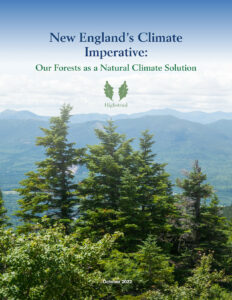
A new report released this week by Highstead lays out five separate but complementary pathways that could increase the climate benefit of New England’s Forests. According to the report, New England’s Climate Imperative: Our Forests as a Natural Climate Solution (Meyer et al 2022), New England Forests already absorb 14% of CO2 emissions, and that number could increase to 21% of current emissions by 2050 by adopting these five pathways: avoided deforestation, wildland reserves, improved forest management, mass timber construction and urban and suburban forests.
New England forests are a critical yet underutilized tool in fighting climate change. They store massive amounts of carbon—and each year they sequester more. Despite the work our forests are already doing to keep CO2 out of the atmosphere, they could do substantially more. As New England states work to meet their 2050 goals for reducing emissions, the relative importance of forest-based mitigation will grow. This report identifies five distinct but complementary pathways that illustrate how New England forests can do even more to tackle climate change. By implementing these five pathways, especially if done together, New England can advance conservation and increase the climate mitigation potential of forests.
Avoided Deforestation:
Each year, 28,000 acres of forests are permanently converted to development, emitting their stored carbon and forgoing all future sequestration. We must reduce this rate of forest loss. If we reduce deforestation to 7,000 acres per year in New England, 74 million tons of Carbon Dioxide Equivalent (CO2e) would be kept out of the atmosphere by 2050.
Wildland Reserves:
Less than 4% of our forests are currently protected as wildland reserves. We need to ensure that a minimum of 10% of New England’s forests are allowed to grow and mature without the influence of any extractive land uses. This would sequester an additional 50 million tons CO2e by 2050.
Improved Forest Management:
Society is heavily dependent on wood products, and New England is a great place to grow trees. By changing our management practices and stewarding timberlands to maximize carbon sequestration, we can maintain harvest volumes while increasing carbon storage in the forest. If just 50% of harvests employed climate smart techniques, an additional 203 million tons CO2e could be sequestered by 2050.
Mass Timber Construction:
Trees are a valuable climate solution inside and outside the forest. Using mass timber building materials is much less carbon intensive than steel or concrete and has the added benefit of storing carbon through the life of the building. If 50% of the eligible new buildings used mass timber construction, an additional 15 million tons CO2e could be stored.
Urban and Suburban Forests: Expanding tree and forest cover within our communities has enormous benefits even beyond carbon, including shading, clean air, clean water, and recreational and employment opportunities. A 5% increase in urban tree canopy in New England could sequester an additional 17 million tons CO2e by 2050
By the Numbers
- Taken together at the middle tier, the cumulative potential carbon benefits of the five pathways would lead to 358 million additional tons CO2e stored in the forest by 2050.
- 358 million tons of CO2e is equivalent to displacing the total 30-year energy consumption of nearly 1.3 million households in New England (from p. 38 – no citation)
- 14% of CO2 emissions is absorbed by New England forests each year
- 21% of current CO2 emissions could be sequestered by adopting these 5 pathways at the middle tier.